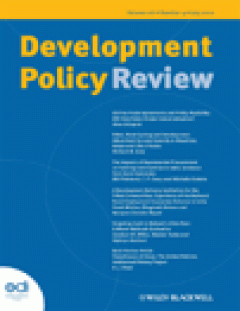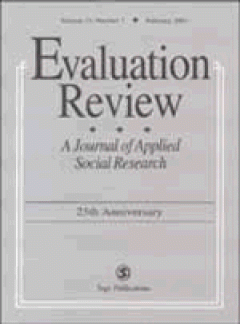Filter by

Agricultural Exports and Food Insecurity in Sub-Saharan Africa : A Qualititat…
Export of agricultural products is increasingly seen as one of the few viable instruments to solve the problem of food insecurity in developing countries. Using the configurative comparative method to study 17 countries in sub-Saharan Africa, this article argues that increasing agricultural export is only beneficial for certain types of developing countries. Before agricultural exports are enco…
- Edition
- Volume 29, Issue 6, November 2011, pages 729–748
- ISBN/ISSN
- 09506764
- Collation
- -
- Series Title
- Development Policy Review
- Call Number
- -

Newcomers to Like-Minded Aid and Donor Darlings : The Strange Case of Spain i…
This article analyses the motives behind the relations between Spain as a donor and Vietnam as a recipient of international aid. The main hypothesis is that this relationship does not respond to the traditional causes for international aid, as identified by the academic literature. On the basis of qualitative data collected in interviews with elites, the article suggests instead that a �learnin…
- Edition
- Volume 29, Issue 6, November 2011, pages 749–770
- ISBN/ISSN
- 09506764
- Collation
- -
- Series Title
- Development Policy Review
- Call Number
- -

Who votes in Africa? An examination of electoral participation in 10 African …
The question �Who votes in Africa?� has yet to receive significant attention. We use Afrobarometer survey data to assess the determinants of voting for over 17,000 voting-age adults in 10 African countries. We find that Africans are driven by many of the same forces as their counterparts elsewhere. The agencies of mobilization are important in determining who votes in these countries. Notably, …
- Edition
- Vol. 17 no. 6, November 2011,pp. 767-799
- ISBN/ISSN
- 13540688
- Collation
- -
- Series Title
- Party Politics
- Call Number
- -

Assimilation, contrast and voter projections of parties in left-right space :…
When voters place parties in their system along the left-right dimension, they often pull their preferred party closer towards them (assimilation) and push the opposition further away (contrast). This article asks a simple question: are such assimilation and contrast effects similarly powerful across different types of electoral system? I hypothesize that systems employing single-member distric…
- Edition
- Vol. 17 no. 6, November 2011.pp. 711-743
- ISBN/ISSN
- 13540688
- Collation
- -
- Series Title
- Party Politics
- Call Number
- -

Conceptualizing Left and Right in comparative politics : Towards a deductive …
Despite the importance of the Left-Right dimension in comparative politics, establishing an index that captures this dimension in both a theoretically and empirically sound manner remains an ongoing challenge for political scientists. Having reviewed existing attempts to construct measures for the Left-Right dimension, and having concluded that they are merely inductive and problematic from a m…
- Edition
- Vol. 17 no. 6. November 2011,pp. 745-765
- ISBN/ISSN
- 13540688
- Collation
- -
- Series Title
- Party Politics
- Call Number
- -

Doomed to disagree? Party-voter discipline and policy gridlock under divided …
This article explains the existence of policy gridlock in systems with divided government, even when there are policies that are universally preferred to the status quo. It is shown analytically that one dimension of party institutionalization (the degree of party-voter discipline) may create incentives for veto players to block policies that, ideologically, they might like. This is the case be…
- Edition
- Vol. 17 no. 6, November 2011,pp. 801-822
- ISBN/ISSN
- 13540688
- Collation
- -
- Series Title
- Party Politics
- Call Number
- -

Wedge-issue dynamics and party position shifts : Chinese exclusion debates in…
Even when the stakes of party-building are high, political parties often find their members divided over a key policy position. In post-Reconstruction America, the hot-button issue of excluding Chinese immigrant workers strengthened Democratic cohesion while splitting the �party of Lincoln�. Previous research has not completely investigated the role of party competition and cohesiveness in pavi…
- Edition
- Vol. 17 no. 6, November 2011,pp. 823-847
- ISBN/ISSN
- 13540688
- Collation
- -
- Series Title
- Party Politics
- Call Number
- -

Evidence-Based Versus Junk-Based Evaluation Research : Some Lessons From 35 Y…
- Edition
- Vol. 35 no. 3, June 2011.pp. 191-203
- ISBN/ISSN
- 0193841X
- Collation
- -
- Series Title
- Evaluation Review
- Call Number
- -
- Edition
- Vol. 35 no. 3, June 2011.pp. 191-203
- ISBN/ISSN
- 0193841X
- Collation
- -
- Series Title
- Evaluation Review
- Call Number
- -

Conventional and Piecewise Growth Modeling Techniques : Applications and Impl…
This article reviews the mechanics of conventional and piecewise growth models to demonstrate the unique affordances of each technique for examining the nature and predictors of children�s early literacy learning during the transition from preschool through first grade. Using the nationally representative Family and Child Experiences Survey (FACES) data set, 1997 cohort, the authors show how pi…
- Edition
- Vol. 35 no. 3, June 2011,pp. 204-239
- ISBN/ISSN
- 0193841X
- Collation
- -
- Series Title
- Evaluation Review
- Call Number
- -

Testing Mediation Using Multiple Regression and Structural Equation Modeling …
Mediation analysis in child and adolescent development research is possible using large secondary data sets. This article provides an overview of two statistical methods commonly used to test mediated effects in secondary analysis: multiple regression and structural equation modeling (SEM). Two empirical studies are presented to illustrate the respective circumstances in which the two methods a…
- Edition
- Vol. 35 no. 3, June 2011,pp. 240-268
- ISBN/ISSN
- 0193841X
- Collation
- -
- Series Title
- Evaluation Review
- Call Number
- -

Methodological Considerations in Using Complex Survey Data : An Applied Examp…
Complex survey data are collected by means other than simple random samples. This creates two analytical issues: nonindependence and unequal selection probability. Failing to address these issues results in underestimated standard errors and biased parameter estimates. Using data from the nationally representative Head Start Family and Child Experiences Survey (FACES; 1997 and 2000 cohorts), th…
- Edition
- Vol. 35 no. 3, June 2011,pp. 269-303
- ISBN/ISSN
- 0193841X
- Collation
- -
- Series Title
- Evaluation Review
- Call Number
- -

Complex Sample Data Recommendations and Troubleshooting
Complex survey data, as highlighted in this issue of Evaluation Review, provide a wealth of opportunities for answering methodological and/or applied research questions. However, the analytic issues of nonindependence and unequal selection probability must be addressed when analyzing this type of data. Thus, to ensure that research questions are accurately answered when using complex survey dat…
- Edition
- Vol. 35 no. 3, June 2011,pp. 304-313
- ISBN/ISSN
- 0193841X
- Collation
- -
- Series Title
- Evaluation Review
- Call Number
- -

Politically Allocated Land Rights and the Geography of Electoral Violence : T…
Large literatures in political theory and political economy argue that private property regimes help support liberal electoral regimes by constraining majoritarian politics, lowering the stakes of elections, and protecting �fundamental� or minority rights. This article probes implications of this argument for elections in sub-Saharan Africa, a mostly rural continent where only about 2% to 10% o…
- Edition
- Vol. 44 no. 10, October 2011,October 2011, pp. 131
- ISBN/ISSN
- 00104140
- Collation
- -
- Series Title
- Comparative Political Studies
- Call Number
- -

The Global Diffusion of Regulatory Agencies : Channels of Transfer and Stages…
The autonomous regulatory agency has recently become the �appropriate model� of governance across countries and sectors. The dynamics of this process are captured in the authors� data set, which covers the establishment of agencies in 48 countries and 15 sectors for the period 1966-2007. Adopting a diffusion approach to explain this broad process of institutional change, the authors explore the…
- Edition
- Vol. 44 no. 10, October 2011.pp. 1343-1369
- ISBN/ISSN
- 00104140
- Collation
- -
- Series Title
- Comparative Political Studies
- Call Number
- -

Too Close for Comfort? Immigrant Exclusion in Africa
Why do some immigrant minorities in the developing world integrate into their host societies whereas others face exclusion and hostility? This article offers new insights on the determinants of political identity and group relations in ethnically diverse societies through the lens of South-to-South migration. Using original data from surveys and interviews collected during 12 months of field re…
- Edition
- Vol. 44 no. 10, October 2011,pp. 1370-1396
- ISBN/ISSN
- 00104140
- Collation
- -
- Series Title
- Comparative Political Studies
- Call Number
- -

Determinants of Attitudes Toward Transitional Justice : An Empirical Analysis…
Much has been said about the institutional determinants of transitional justice (TJ), yet scholars still know little about the determinants of citizens� attitudes toward restorative policies aimed at addressing human rights violations of the past. This article draws on an original survey of a representative sample of Spanish citizens conducted in 2008. One year earlier, the Spanish socialist go…
- Edition
- Vol. 44 no. 10, October 2011,pp. 1397-1430
- ISBN/ISSN
- 00104140
- Collation
- -
- Series Title
- Comparative Political Studies
- Call Number
- -

The Legitimacy of Political Institutions : Explaining Contemporary Populism i…
Populism is an enduring feature of Latin American electoral democracies. Within the past decade, scholars have witnessed the political ascendancy of populist politicians from both the left and right of the ideological spectrum. This naturally raises the question as to why populism has proven resilient in some Latin American democracies, whereas in others political forces have remained relativel…
- Edition
- Vol. 44 no. 11, November 2011,pp. 1447-1473
- ISBN/ISSN
- 00104140
- Collation
- -
- Series Title
- Comparative Political Studies
- Call Number
- -

Unsuccessful Success? Failed No-Confidence Motions, Competence Signals, and E…
If no-confidence motions are primarily motivated by bringing down governments, why do only approximately 5% of no-confidence motions in advanced parliamentary democracies from 1960 result in the termination of government? In this project the author addresses this puzzle by developing a formal model of the electoral benefits of no-confidence motions and tests these hypotheses with the use of an …
- Edition
- Vol. 44 no. 11, November 2011,pp. 1474-1499
- ISBN/ISSN
- 00104140
- Collation
- -
- Series Title
- Comparative Political Studies
- Call Number
- -

Support for Polyarchy in the Americas
This study measures support for the basic rights, liberties, and practices associated with polyarchy in 12 Latin American democracies. Specifically, it identifies five profiles of support for polyarchy�s core values and norms�public contestation, inclusive participation, limits on executive authority, and institutional checks and balances. Although citizens who fit the polyarch profile accept a…
- Edition
- Vol. 44 no. 11, November 2011,pp. 1500-1526
- ISBN/ISSN
- 00104140
- Collation
- -
- Series Title
- Comparative Political Studies
- Call Number
- -

Do International Election Monitors Increase or Decrease Opposition Boycotts?
Election boycotts are over twice as common when international observers are present. Do international observers increase election boycotts as this correlation and past research suggest? This article argues not. Observers tend to go to elections with many problems, and it is primarily these, rather than monitors, that drive boycotts. Furthermore, opposition parties have reasons to hope that obse…
- Edition
- Vol. 44 no. 11, November 2011.pp. 1527-1556
- ISBN/ISSN
- 00104140
- Collation
- -
- Series Title
- Comparative Political Studies
- Call Number
- -
 Computer Science, Information & General Works
Computer Science, Information & General Works  Philosophy & Psychology
Philosophy & Psychology  Religion
Religion  Social Sciences
Social Sciences  Language
Language  Pure Science
Pure Science  Applied Sciences
Applied Sciences  Art & Recreation
Art & Recreation  Literature
Literature  History & Geography
History & Geography